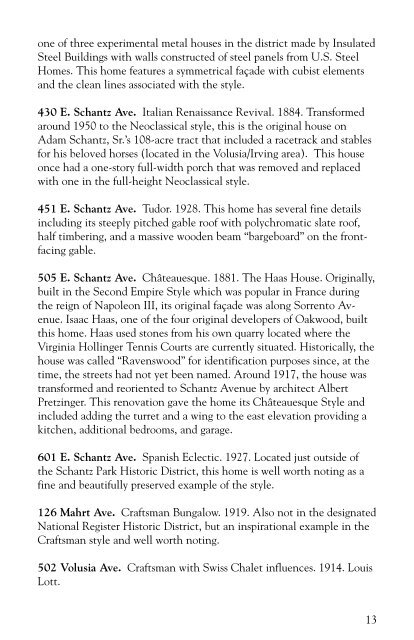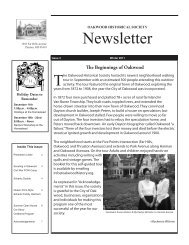Schantz Park Historic District Self-Guided Walking Tour - Oakwood ...
Schantz Park Historic District Self-Guided Walking Tour - Oakwood ...
Schantz Park Historic District Self-Guided Walking Tour - Oakwood ...
You also want an ePaper? Increase the reach of your titles
YUMPU automatically turns print PDFs into web optimized ePapers that Google loves.
one of three experimental metal houses in the district made by Insulated<br />
Steel Buildings with walls constructed of steel panels from U.S. Steel<br />
Homes. This home features a symmetrical façade with cubist elements<br />
and the clean lines associated with the style.<br />
430 E. <strong>Schantz</strong> Ave. Italian Renaissance Revival. 1884. Transformed<br />
around 1950 to the Neoclassical style, this is the original house on<br />
Adam <strong>Schantz</strong>, Sr.’s 108-acre tract that included a racetrack and stables<br />
for his beloved horses (located in the Volusia/Irving area). This house<br />
once had a one-story full-width porch that was removed and replaced<br />
with one in the full-height Neoclassical style.<br />
451 E. <strong>Schantz</strong> Ave. Tudor. 1928. This home has several fine details<br />
including its steeply pitched gable roof with polychromatic slate roof,<br />
half timbering, and a massive wooden beam “bargeboard” on the frontfacing<br />
gable.<br />
505 E. <strong>Schantz</strong> Ave. Châteauesque. 1881. The Haas House. Originally,<br />
built in the Second Empire Style which was popular in France during<br />
the reign of Napoleon III, its original façade was along Sorrento Avenue.<br />
Isaac Haas, one of the four original developers of <strong>Oakwood</strong>, built<br />
this home. Haas used stones from his own quarry located where the<br />
Virginia Hollinger Tennis Courts are currently situated. <strong>Historic</strong>ally, the<br />
house was called “Ravenswood” for identification purposes since, at the<br />
time, the streets had not yet been named. Around 1917, the house was<br />
transformed and reoriented to <strong>Schantz</strong> Avenue by architect Albert<br />
Pretzinger. This renovation gave the home its Châteauesque Style and<br />
included adding the turret and a wing to the east elevation providing a<br />
kitchen, additional bedrooms, and garage.<br />
601 E. <strong>Schantz</strong> Ave. Spanish Eclectic. 1927. Located just outside of<br />
the <strong>Schantz</strong> <strong>Park</strong> <strong>Historic</strong> <strong>District</strong>, this home is well worth noting as a<br />
fine and beautifully preserved example of the style.<br />
126 Mahrt Ave. Craftsman Bungalow. 1919. Also not in the designated<br />
National Register <strong>Historic</strong> <strong>District</strong>, but an inspirational example in the<br />
Craftsman style and well worth noting.<br />
502 Volusia Ave. Craftsman with Swiss Chalet influences. 1914. Louis<br />
Lott.<br />
13




